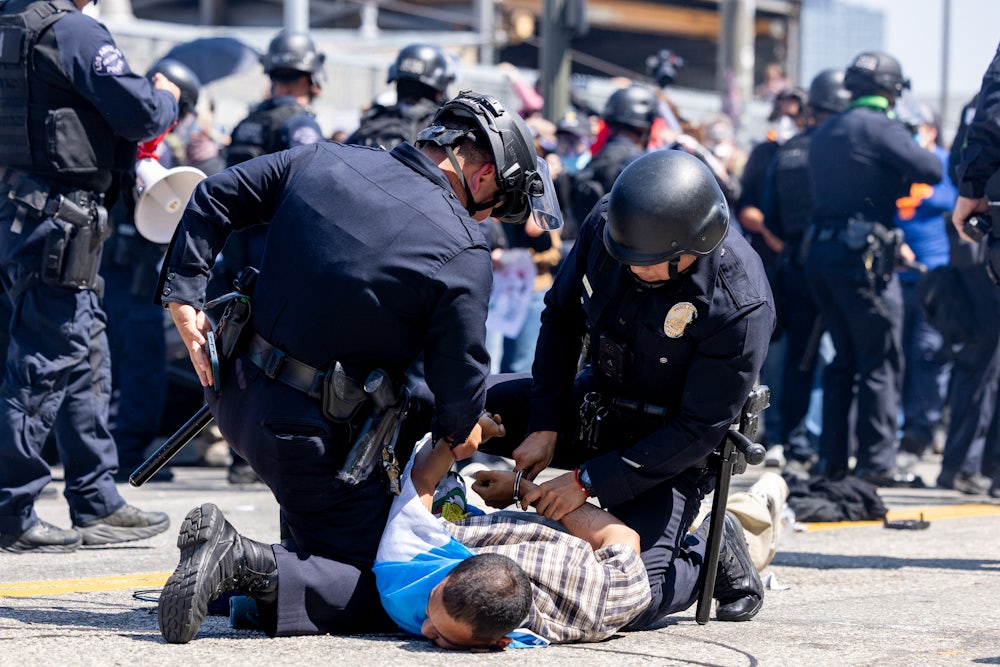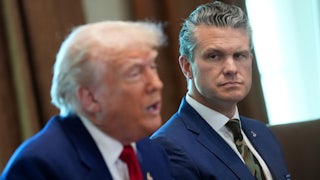Early Sunday evening in Los Angeles, as the city was under siege by federal anti-immigration forces, aided by local law enforcement, Mayor Karen Bass was holding a press conference. Out in the streets, a reporter noted, it appeared that the Los Angeles Police Department was “cooperating” with Immigration and Customs Enforcement, “using flashbangs and less-lethal munitions” to push people engaged in “peaceful protest” away from a federal building being used as an ICE detention center. The reporter asked if Mayor Bass would comment on this cooperation, which is against city policy. “What happened there,” Bass began, “is that when one branch of law enforcement says they need help, another branch of law enforcement is going to respond.” In this case, she said, LAPD’s aim was to control the protest. She distinguished its actions from the department’s “coordinating with ICE in terms of raiding workplaces or arresting people who are undocumented.”
The Los Angeles mayor was trying to draw a line: While the LAPD is not supposed to be directly raiding workplaces or arresting undocumented immigrants alongside ICE, it is free to police the public so that ICE can raid workplaces and arrest undocumented immigrants. For those in the streets, choking down tear gas and dodging disabling “less-lethal” bullets as they try to defend themselves and one another from violent raids, this is a distinction without a difference.
Angelenos mobilized this weekend, after ICE descended on their city and over several days began making very public arrests. Last week, people arriving at their mandatory ICE check-ins at a federal building were instead quickly locked up in a makeshift detention center, where as many as 200 people were being held in basement rooms. (“No food. No water. Locked in holding rooms for over 12 to 24 hours,” said Democratic Representative Jimmy Gomez, who represents parts of Los Angeles.) Dozens of people were arrested at a Home Depot on Friday by masked agents in tactical gear. Multiple federal agencies assisted ICE. One witness described unidentified agents descending on food vendors nearby: “They were just grabbing people. They don’t ask questions. They didn’t know if any of us were in any kind of immigration process.” Another witness said that he was in his car when ICE agents stopped traffic, “in all their military gear.” People in the traffic jam could see ICE putting people into vans. “We weren’t there to protest,” the man told KCAL-TV, but when people got out of their cars and began to record with their phones, they were tear-gassed. As ICE agents raided a business in the Fashion District, footage of some community members challenging them indicates, LAPD was apparently stationed outside. And as the news of the raids spread, and more people came out to witness and protest, LAPD was there to push back, to control, to demobilize.
For Bass, it seemed, the problem was not that the LAPD was violently policing those protesting ICE raids; the problem was Trump’s calling in the National Guard to do the same thing. By this logic, the ICE raids, conducted with the support of myriad federal agencies, are a terrifying abuse of power that police should not collaborate in—but it’s fine for police to collaborate by keeping protesters and witnesses away. The upside-down thinking goes even further: It’s wrong for the National Guard to put down protests against the will of the governor and city officials, but it’s fine for state and local law enforcement to do it, so long as state and local officials want them to. The line of reasoning is maddening, seemingly designed to scramble and demobilize support for the people of Los Angeles. Accept the terms of the debate, and you end up in a bizarre argument about how much violence, from which armed agents of the law, is acceptable.
Those with the clearest view are the ones bearing the brunt of such attacks. Whether it’s the sheriffs, police, or Border Patrol, “it was brutal violence,” said Ron Gochez, a community organizer, who was part of the protests. “What they didn’t think was going to happen was that the people would resist.” Over eight hours on Saturday, he said, after a battle with Border Patrol—“and it was a battle, because there were people throwing back tear gas, people throwing anything that they could to defend themselves and to defend the workers that were being surrounded”—the Border Patrol retreated. “And the hundreds of workers that were in the factories around them were able to escape,” Gochez recounted. “They were able to go to their cars and go home. That was only thanks to the resistance that allowed them to go home that night.” If any community was going to fight back without apology, it was this one.
“ICE raids in LA are a declaration of war,” longtime immigration reporter Tina Vásquez wrote at Prism on Monday. Los Angeles was built by communities who have survived and fled political persecution and state violence, she pointed out, and who have faced it again—including from police—in their new homes. “When you are an Angeleno and this is your lineage, you are fully aware of what local law enforcement is capable of,” she added, and when the LAPD attempts to distance itself from ICE raids, “you know better.” No one outside of Los Angeles should be surprised: “ICE sent the city of Los Angeles a message when its agents showed up in full force and in broad daylight, and that message was responded to in kind by the people.”
Bass might say that she supports the people’s right to respond, but she wasted little time before admonishing her constituents for not responding in the right way. “The most important thing right now is that our city be peaceful,” Bass said at the Sunday press conference. “Expressing your fears, your beliefs, is appropriate to do, but it is just not appropriate for there to be violence.” Drawing lines between “peaceful” and “violent” is a common move for politicians amid popular protest. They continue to urge so-called nonviolence even as such directions can feel quite difficult to follow in a cloud of tear gas you did not set off. It’s nearly impossible to figure out what compliance is supposed to look like when police are launching weapons of war on the public. In such a gross imbalance of power, the police are the ones really drawing the lines. No matter what a peaceful protester may intend, it’s police who are deciding when to use violence and whom to use it against—and nothing we saw this weekend indicates their violence was confined to those who were not “peaceful.”
It is very difficult to believe that Los Angeles’s political leadership—or California’s governor or other state officials—truly wish to stop ICE raids when they are willing to arrest the only people who are actually standing in ICE’s way. The politicians want to define protest as merely voicing a demand without disrupting anything; they don’t want to recognize the value of putting one’s body between the state and the scapegoated. There is apparently no “peaceful” way to do that in Los Angeles. And for those of us elsewhere, who would like these raids on immigrants to end, who want to end Trump’s abuse of power—we will fail if we defer to such “leadership” and line drawing. What we are witnessing in Los Angeles is not only a protest; it is self-defense.


